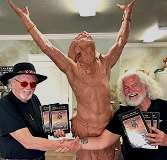Sixty-five Days Aboard The John J. Boyd
"There were 508 passengers on board. We had a very rough voyage over the Atlantic. We got in New York on the 15th of February, 1856."
Peter Gottfredson Autobiography - Part 1
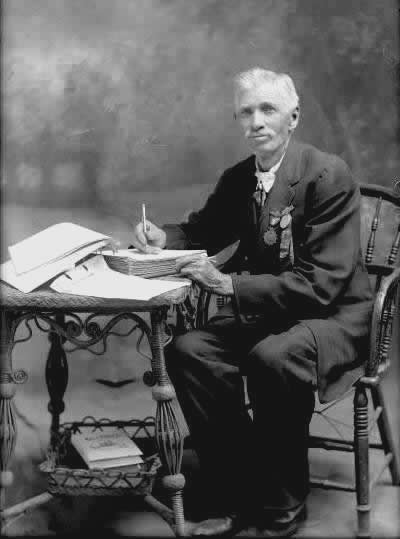
Peter Gottfredson
1838 - 1934
Peter Gottfredson, a Mormon emigrant from Denmark, lived his life in a mercurial environment with paradoxes and moral ambiguities, a volatile atmosphere charged with dogma, greed, religious fanaticism, and dire circumstances. For Peter, the innocence of youth was a luxury he could ill afford, caught up, as he was, in the currents of settler colonialism.
As a teenager, when he first became acquainted with the Timpanogos Tribe in Utah. He was a herd boy in the Thistle Valley area of southern Utah, which he describes as most frequented by the Timpanogos during the Black Hawk War. While tending sheep and cattle as herdsmen, they often come into his camp, hungry and and at time tramatized from the battle field. Peter would share his meals and listen to their concerns.
Peter, a compassionate man, was involved with the Timpanogos, and he saw the devastating effects of settler colonialism, which undoubtedly gave him cause to feel caught between the two cultures at times. And it followed that he would witness firsthand their agony as they struggled to keep their land and freedom and perish from hunger, disease, and hopelessness. Peter would have been about 13 years younger than Black Hawk. He maintained a close alliance with the Timpanogos well into his adulthood. He understood the Timpanogos culture intimately by learning their sacred ways and survival skills in a natural environment.
He became a journalist for the Richfield Advocate chronicling the Sanpete War, later known as the Black Hawk War. In his later years, he served as a Mormon bishop for 20 years in Glenwood, Utah, until he resigned.
1989, at the age of 65, Peter began writing the book Indian Depredations in Utah in which he published in 1919. A firsthand 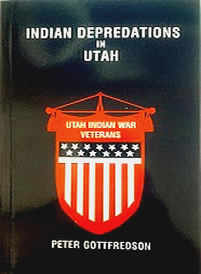 account of the Utah Black Hawk War he wrote: "I have often queried, why should those conditions be forgotten, and why has so little interest been taken in keeping memoranda's and records of events and conditions of those early and trying times?" For twenty years Peter was a bishop of the LDS church in Glenwood, Utah, until he retired. He was a friend of Chief Antonga Black Hawk and spent much of his time in their camps. He compiled any number of tell-all reports of early Mormon racism and cold-hearted brutality that happened over more than two decades. Please take a few minutes and read some excerpts from his book. account of the Utah Black Hawk War he wrote: "I have often queried, why should those conditions be forgotten, and why has so little interest been taken in keeping memoranda's and records of events and conditions of those early and trying times?" For twenty years Peter was a bishop of the LDS church in Glenwood, Utah, until he retired. He was a friend of Chief Antonga Black Hawk and spent much of his time in their camps. He compiled any number of tell-all reports of early Mormon racism and cold-hearted brutality that happened over more than two decades. Please take a few minutes and read some excerpts from his book.
To the honor of Peter Gottfredson, researchers, journalists, and scholars quote from his book Indian Depredations in Utah, in countless publications and articles underscore the importance of this time-honored account. The Salt Tribune noted in 2002, "...the book reports any number of white depredations that would otherwise be unknown, and like the Iliad, the losers are often more courageous and noble than the victors," wrote historian Will Bagley.
Before his passing in 1934, Peter wrote his autobiography. He wrote the moments and events that were most memorable and foremost in his memory. Peter was laid to rest at Glenwood, Utah. See Peter Gottfredson's Eulogy.
As a great-grandson of Peter, it is my honor to share his remembrances with you. - Phillip B Gottfredson author Black Hawk's Mission of Peace.
Acknowledgment: "A special thank you to my cousin Briant Jenson, a great-grandson of Peter Gottfredson. Briant was so kind to give to me a photocopy of Peter's autobiography." - Phillip B Gottfredson
PETER GOTTFREDSON
At the tender age of eleven, Peter Gottfredson journeyed with his parents and two siblings from Denmark to America in 1855. Peter would become a passionate journalist, storyteller, historian, and author. Because he was aware of living in a historical time, he was genuinely motivated to record his personal experiences. Peter compiled numerous tell-all firsthand accounts of those times. He lived in a violent and dangerous world from when he left his home and throughout his life. The violence and human suffering he witnessed made him what he was. It was his environment that defined him as a compassionate human being. He never spoke ill of anyone.
Peter wrote, "I can look back and see the mistakes I have made, also the successes. In my minds eye I can see where I could have done better, but would I. I hold here a manuscript of my life, including names of many who have associated with, socially, in business and the family relation. It contains more than three hundred pages. In the preface I mention the little daily occurrences and parts that make up the great whole. We can look back and see where we could have done better, but would we. Environments have much to do with shaping our natures character and destiny. Had we at certain stage in life taken a different course it is impossible to know where it would ultimately have led to. So I say, it is no use to harbor regrets, but necessary to make the best of the future. Life is a stream leading to somewhere. I have often in my minds eye compared it with starting out on a highway with many roads leading off in different directions, each leading to a different place and in each place conditions differ, as do the people with whom we would associate. Which would affect our condition in life, physically, morally and intellectually, and who shall say which would have been the best road for us to have followed; and here we are, so I say, and advice; try to so live each day that there will be no regrets."

PETER GOTTFREDSON AND FAMILY 1882
Left to right: Wilford, Peter, James Edward, Amelia, Rosella Ann.
I married Amelia Gledhill in April, 1872, and contracted with her sister's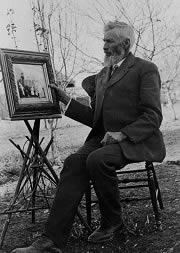 husband, Bernard Snow to bring log to his saw-mill to be sawed into lumber. Each to have half. I took my young wife to the mill to cook, and we engaged her brother Thomas Gledhill to help me get logs to the mill. With three yoke of large oxen. We worked until the 26th of September, when Indians from ambush killed one of our number and wounded another. In 1882 at the age of 36, when this picture was taken, I was requested by the editor of our local paper, the Richfield Advocate, to write up the circumstances for publication, which I did, with the assistance of my wife, her brother Thomas, and my brother-in-law Colonel John L. Ivie, which was the beginning of the compilation of this history. (Indian Depredations in Utah) husband, Bernard Snow to bring log to his saw-mill to be sawed into lumber. Each to have half. I took my young wife to the mill to cook, and we engaged her brother Thomas Gledhill to help me get logs to the mill. With three yoke of large oxen. We worked until the 26th of September, when Indians from ambush killed one of our number and wounded another. In 1882 at the age of 36, when this picture was taken, I was requested by the editor of our local paper, the Richfield Advocate, to write up the circumstances for publication, which I did, with the assistance of my wife, her brother Thomas, and my brother-in-law Colonel John L. Ivie, which was the beginning of the compilation of this history. (Indian Depredations in Utah)
See Sad Chapter of Warfare Between Pioneers and Indians Will Bagley

Black Hawk Veterans War Medal belonged to Peter Gottfredson author of book Indian Depredations in Utah.
From Denmark To New York In Three Months
"The small boys picked at me because my parents were Mormons."
I, Peter Gottfredson was born in Jutland Denmark, near the coast of the North Sea, the 17th of April 1846. My earliest recollection is when I was four years old, or in 1850. I remember that I knew fifty was half a hundred. I also remember that a total eclipse of the sun happened about noon when it was dark as night for a time. That my sister Mette Christine was born that summer and that some neighbor children were at our house to play with my brother Hans and I. That their mother was there to wait on our mother. They were our nearest neighbors and lived about a fourth of a mile distant. Their father’s name was Niels Christian Nielsen. They had three boys, Bartel, Andrew and Erick. Their girls’ names were Christense, Ane Cathrine and Karen Marie. Later a baby girl was born named Nelsine Chrestine. This family emigrated to America when we did, in the same ship. They lived neighbors to us in Saint Louis, Missouri. The father died there on the 12th of April 1857.
Where we lived in Denmark the soil was very poor and sandy, having no doubt been washed up from the ocean. The native vegetation there was a small brush called heath and there were wild blueberries that we gathered. The houses were few and scattered, with small gardens adjoining. Most of the land was unoccupied. A sluggish stream ran through the country, called Red O/e. A poor quality of grass grew along its banks where water overflowed in the spring of the year. The fuel was mostly peat, or turf, a sod dug out of bogs in square blocks and laid on the high ground to dry. It was mostly decayed vegetation, and served the purpose very well.
Father’s name was Jens Gottfredson. He was born in North Sundby, near Aalborg, 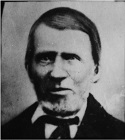 Denmark, 9th April 1810. But little is known of his parentage. His mother was a widow. Her name was Mette Chrestine Jensen. I do not know the date of her birth. She had a daughter in Copenhagen. I do not know her name. Her husband’s name was Hans Jensen Trelde. They kept a tea and coffeehouse. Denmark, 9th April 1810. But little is known of his parentage. His mother was a widow. Her name was Mette Chrestine Jensen. I do not know the date of her birth. She had a daughter in Copenhagen. I do not know her name. Her husband’s name was Hans Jensen Trelde. They kept a tea and coffeehouse.
While quite young father was bound out as an apprentice to learn the cooper’s trade. The master was very strict and father became a proficient workman. First as assistant and later as master mechanic.
Mother’s maiden name was Karen Jensen Pedersen. She was christened Jensen, that being her father’s given name. This was customary in Denmark. She was born the 23rd May 1912 in Westerby, Øland, Denmark. She had four brothers, Christen, Peder, Lars and Poul and two sisters, Helene and Anne.
Grand father’s name was Jens Pedersen and grandmother’s maiden name was Else Magrete Christensen Møller, The o with a line across was pronounced as "i in bird. Mother’s grandparents names were Christen Møller, his wife’s name was Ane. Her great grandparents’ names were Peder Møller and his wife Magrete.
Mother’s parents were well to do farmers and owned a large farm and kept several servants.
Father served in the Danish Army six years and held the rank of Corporal. That was previous to marrying mother. They were married in the year 1845. They were born Lutherans which was the dominant church in Denmark. Later they joined the Baptist’s. During the winter of 1851 two Mormon missionaries came to our house and wished to stay over night, to which father consented on condition that they were not to teach their doctrine to his wife. He thought they could not deceive him. My parents were very enthusiastic in the Lutheran faith. During the evening father told the Mormons of the doctrine of the Baptist’s saying, they practiced baptism by immersion as was practiced in the days of the Savior, and other things that were scriptural, with which the Elders agreed, they said, that is not all. They got the bible and were shown and discussed doctrine that they had not thought of. Out parents became very much interested and invited the Elders to come again, which they did. It was not long till our parents became converted and were baptized when they had to cut ice quite thick to administer the ordinance. My impression of the Elders was that they were good men. They were neatly dressed and spoke pleasantly. They spoke to me, which pleased me, and I thought I was of some importance. I was five years old. We, for all of being young were interested and learned to join our parents in singing hymns. We would get stick horses and ride to Zion, as Utah was termed by the Mormons. Our youngest brother was born shortly after our parents joined the church. On the 3rd of July 1852. They named him Joseph Smith in honor of the Prophet. When our parents went to have his name entered on the records of the Lutheran church, which was required by law, that being the national, or predominating church, the Priest refused to enter his name saying he would not have such a degraded name on the record.
One of the Elders who converted our parents, his name was Fjelsted. Later he and father traveled together as missionary companions. Father told of a circumstance when a mob got after them and tied a rope around them and let them down in a well with deep water in it, saying they were baptizing them.
In the fall of 1852 I was taken to my grandmothers at Westerby, Øland to stay with them. My grand father had died and grand mother had married their main hired man. His name was Peder Christian Ton. I called him grandfather. They were very kind to me and I learned to love them as my own parents. They kept several servants and had large buildings and barns and kept a number of teams, cows, sheep, pigs and poultry of different kinds. I was with them nearly three years. When I was taken there my parents lived in a small town called Kaas. There is where my brother Joseph was born. Our parents moved from there to Aalborg, a city of some considerable size where father took up the business of peddling. He bought articles at auction and other cheep sales and took them into the country and traded them for butter, eggs, rags, bones, etc. Mother came to grandmother’s on a visit and brought my two brothers and my sister who I had not seen for two years. She brought me a pair of skates that father bought at auction. They were the nicest in the neighborhood and I was very proud of them. I soon learned to use them well for a small boy. One moonlight night when the fjord was frozen over, which was a Danish mile wide, four American miles, I with a number of other boys, my size and older, crossed over on the ice and went up to a town called Nibe where there were some stores. I had never seen a store before; there were none where I had lived. The people did their trading with peddlers. Some times they would ago to a city to make purchases. The people in the country places made their clothing. They raised sheep and spun the wool into yarn and wove it into cloth on hand looms. They raised nearly all their foodstuff and what they needed. Peddlers generally stopped at my grandmothers and had me notify they people that they were there and what they had for sale, for which they game me a few skillings. A skilling was about half a cent in American money.
I had several uncles, aunts and cousins there. None of them were Mormons, but they were kind to them, which was not the case with all people. The small boys picked at me because my parents were Mormons. At one time they wanted me to swear like they did. My parents had told me it was wicked and because I would not they rolled me in high grass when it was wet with dew till was as wet as if I had been dipped in water. We were on our way to school. When the teacher asked what made me so wet, I told him. He took to boys to task and they did not molest me any more. That incident may have had something to do with me not getting in the habit of profaning. I can not remember ever taking an oath. I could not see any satisfaction in it.
I bought a little ship in full rig, about eighteen inches long that I sailed on a pond near grandfather’s place. Sometimes a gust of wind would tip it over. A neighbor said it needed ballast, and if I would let him take it he would fix it. He cut the name ”Mormon” on the side of it. I thought it was intended as a reproach on the Mormons and I disliked him for it.
Grandfather, so called, gave me a colt and a calf and said what else he would give me if I would stay with them till I was grown. I thought that would be fine, but would not promise. I thought I could not be a Mormon and go to Zion if I did. I went to school there two seasons, till I was nine years old. In the fall of 1855 father came after me. I felt bad to think I was leaving and might not see them again. Grandmother had died that summer. She had been an invalid for six years, unable to walk, or help herself, caused from rheumatism. Grandfather had married their main hired girl, an old maid. She was not as kind to me as grandmother had been.
When father and I left we walked all the way from Øland to Aalborg. A distance of six Danish miles, twenty-four American miles. It seemed an awful long way. Early in the month of December 1855 we left Aalborg to go to America. We stayed a few days in Copenhagen, visiting with father’s sister and her husband. From there we crossed the North Sea to Kyhl and Hamburg in Germany. The sea was very rough and most of the passengers were seasick. A very disagreeable feeling as I remember. We went by rail from Germany to Liverpool, England, and we sailed from there on the 12th of December, 1855 in the ship John J. Boyd, under the leadership of Knud Peterson who had filled a mission to Norway and Denmark. Knud Peterson became President of the Sanpete Stake of Zion. He was father in law to President Anthon H. Lund.
 On the 12th of December, 1855 we sailed on the John J. Boyd ship. There were 508 passengers on board. We had a very rough voyage over the Atlantic. We got in New York on the 15th of February, 1856, having been sixty five days on the water. We had head winds most of the way. We were about one third of the way over when we were driven back to the coast of Ireland. The vessel was on fire twice. The one time was serious. The fire started in the Captains cabin and burned through the deck and filled the vessel with smoke so the passengers had to go to deck. Some trunks and other baggage that was on fire was thrown into the sea. As I remember more than thirty deaths. I will describe a funeral at sea. After the customary services, the corpse was sewn into a canvas, or sheet, with a large lump of coal at the feet. A plank was laid across the side of the vessel and the corpse was laid on it with feet out. A prayer was offered, the end of the plank raised and the dead would slide into the sea feet foremost and all was over. On the 12th of December, 1855 we sailed on the John J. Boyd ship. There were 508 passengers on board. We had a very rough voyage over the Atlantic. We got in New York on the 15th of February, 1856, having been sixty five days on the water. We had head winds most of the way. We were about one third of the way over when we were driven back to the coast of Ireland. The vessel was on fire twice. The one time was serious. The fire started in the Captains cabin and burned through the deck and filled the vessel with smoke so the passengers had to go to deck. Some trunks and other baggage that was on fire was thrown into the sea. As I remember more than thirty deaths. I will describe a funeral at sea. After the customary services, the corpse was sewn into a canvas, or sheet, with a large lump of coal at the feet. A plank was laid across the side of the vessel and the corpse was laid on it with feet out. A prayer was offered, the end of the plank raised and the dead would slide into the sea feet foremost and all was over.
Several of the sailors were disabled and some died. The captain was a cruel man to the sailors. At one time the vessel sprang a leak; water was running in fast; about thirty sailors were working a large double lever pump with ropes attached to the ends of the levers. One sailor was not working to suit the Captain, he picked up a rope with a heavy hook in the end, and from behind struck the sailor on the head with the hook, killing him instantly. I stood close by watching the pumping and saw it, so did others. The ship was getting short of able bodied sailors and the Captain planned to draught passengers to take the places of disabled sailors. One morning I had occasion to go on deck very early, and looking ahead saw what I thought was a steamship. I went below and told the folks that we would soon be to land, there was a steamship not far ahead. Some of the passengers went up to see, and when the Captain turned his glass on it he discovered that it was a wreaked vessel. What I thought was a smoke stack was the stump of a broken mast. Part of the bulwarks had been torn away by the sea and the waves had swept over the ship and one of the sailors had been swept overboard.
Mutiny occurred on our ship. The Captain did not want to rescue the sailors of the disabled ship. The mates did. We were told that the mates and crew put the Captain in confinement. The first mate with two sailors took a small boat and rowed to the disabled ship. The second mate took charge of our ship. They hung the boat by ropes from the end of the yard arm. A long timber that is fastened across the mast, about twenty feet above the deck which reach out on either side a little past the sides of the ship. The large sail is fastened to it. The boat was hung the end of the arm. The rocking of the ship set the boat swinging with the three men in it. The mate in the back with the steering oar and the two sailors each with large oar ready to pull when the boat struck the water. The boat went out with a big swing; the ropes ran through the pulleys and the boat struck an outgoing wave. It went through the foam and down out of sight on the further side of the wave. It looked as if the boat had been swallowed up in the sea, but soon we saw it gliding up the side of another large wave a hundred yards or more from our ship. Our ship turned around, for at first the wrecked ship was at our right, after a little it was behind us, and then at our left and further away.
The sailors from the wrecked ship came to our ship in a large white boat that held all of them. As I remember there were thirty five. They pulled up beside our ship and a rope ladder was let down that they came up on. Then their boat was hoisted onto our ship. Our mate and two sailors were hoisted up in their boat. The wrecked ship was loaded with flour from America to England. It was left to drift were it would. We watched it as long as we could see it."
After arriving on American shores Peter with his family traveled on to Alton, Illinois. There his mother died from what was called “weaver consumption”. Peter gives the following account.
Mother was afflicted with consumption and died on the 4th of July, 1856. It was called weavers consumption. She had woven on a hand loom most of her life and lint from the material was breathed into her lungs which caused irritation.
Before leaving Denmark mother dreamed of the journey to America. She told the dream and the journey was very much as she told it. She described crossing the ocean and getting to where she died. She did not dream of getting to Utah. Shortly after mothers death we went to Saint Louis, Missouri and stayed there about a year. Father got work at the Filley Foundry, where the Charter Oak Stoves were made. At Saint Louis we without a house keeper. I being the oldest child had to do the cooking and housekeeping as best I could. An Unmarried woman who came from Denmark when we did stopped at Keokuk, Iowa. Father got her to come to Saint Louis and keep house for us. Her name was Karen Marie Pedersen Meilhede. They were married onthe 12th of August, 1856, by a returning missionary by the name of Christian Christiansen. In the spring of 1857 we sailed up the Missouri river to Florence, Nebraska. We stayed there a short time till we started for Utah with Christian Christiansen's handcart company. When we had traveled a distance of about a hundred miles and twenty miles to the Loup Fork river, we crossed over and camped on the west side in a cottonwood grove. The river was a fourth of a mile wide at the ford and had quicksand bottom. If we stopped in the river the handcarts began to sink and was hard to get loose. That night mother gave premature birth to a baby girl. The baby was blessed and named Platine, for the Platt River of which the Loup Fork is a tributary. The baby died and was buried there. The company went on and left us there. We placed mother on the handcart and pulled her back over the river and up north to a small settlement called Genoa. It was located near Beaver Creek where it empties into the Loup River. Genoa had been settled that spring by a few Mormon families. There father staked off a quarter section of land joining the settlement. It was prairie land covered with buffalo grass about a foot high with a stiff hard stem. In the side of a hill father built a dugout and covered it. He left us there and with the handcart went back to Omaha to get work. He had no chance to send us food and we got without. The people raised a little frosted corn and some buckwheat which ripened. We got a little of that which we ground on a coffee mill and mixed with wild plums and sour grapes that grew plentiful along Beaver Creek and the Loup Fork river. We did not see bread for more than a month. Later father sent us a sack of flour and some bacon which tided us over. "
 In November Peter's mother hired a man with a yoke of oxen to take them to Omaha. There were there until spring. There they heard that Johnston's Army was going to Utah to fight the Mormons. The neighbors were kind and tried to persuade Peter's family not to go to Utah. In the spring of 1858 they joined with a wagon train of six wagons. In November Peter's mother hired a man with a yoke of oxen to take them to Omaha. There were there until spring. There they heard that Johnston's Army was going to Utah to fight the Mormons. The neighbors were kind and tried to persuade Peter's family not to go to Utah. In the spring of 1858 they joined with a wagon train of six wagons.
Before we reached Fort Laramie we fell in with a company of soldiers going to Utah. They were a part of Johnston’s Army. This was part of Johnston’s Army that had gone east for supplies. We traveled with them till we reached Devil’s Gate on the Sweetwater. They were very kind to us. They allowed us to camp just outside of their picket line. They often gave us food and they night herded our oxen, all who could had to walk.
Fort Bridger
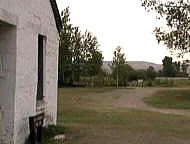 I was twelve years old, the biggest boy in the company. The soldiers let me ride a mule and help drive loose stock. When we reached Sweetwater the troops pushed on to Fort Bridger faster than the ox teams could travel. Father permitted me to go with them. They offered to board and take care of me till our company got there. While there I heard some of their stories about the Mormons. How they kept them at Fort Bridger the winter before and about Lot Smith with a small company of Mormons had burned a number of Government wagons and supplies back on the Big Sandy. One soldier said he would take me back to the States if I wished and give me a home with him. I was twelve years old, the biggest boy in the company. The soldiers let me ride a mule and help drive loose stock. When we reached Sweetwater the troops pushed on to Fort Bridger faster than the ox teams could travel. Father permitted me to go with them. They offered to board and take care of me till our company got there. While there I heard some of their stories about the Mormons. How they kept them at Fort Bridger the winter before and about Lot Smith with a small company of Mormons had burned a number of Government wagons and supplies back on the Big Sandy. One soldier said he would take me back to the States if I wished and give me a home with him.
We arrived in Salt Lake City on the 20th of Sept.. 1858. When we got there many of the people were away. Early in the summer the people has left their homes and had moved south into Utah Valley, owing to the army coming soon. There was an understanding between the Mormon leaders and officers of the army that they should pass through the city and cross the Jordan River where they made camp. From there they went to Cedar Valley where they built a fort called Camp Floyd."
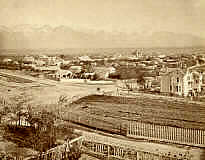
Salt Lake City circa 1870
Information about the John B Boyd ship
added by Phillip B Gottfredson:
Ship: 1311 tons: 195' x 38' x 28'
Built: 1855 by S. G. Bogart at New York City, New York
Named for an early marine merchant, the John J. Boyd was owned by William Tyson of New York. She was a three-decker with a square stern, round tuck, and billet head. Apparently in 1860 this packet ship was damaged by fire and salvaged. In July 1863, probably because of the Civil War, the vessel was sold to foreign owners.
Peter's autobiography continued:
Nearly two thousand Latter-day Saints were transported to America in three voyages by the full-bodied ship John J. Boyd of New York. Her first voyage began at Liverpool on 12 December 1855, just a few months after she was launched. On board were between 508 and 512 Mormon emigrants from Denmark, Norway, Sweden, Iceland, Italy, England, Ireland, and Scotland. Elder Knud Peterson presided over the Saints. The shipmaster was Captain Thomas Austin. He had previously skippered the 1418-ton ship Jacob A. Westervelt and the 1448-ton ship Cultivator. It was a well-ordered company. Rules of cleanliness and conduct were established. A trumpet called the emigrants to prayer morning and evening, and religious services were held frequently in the English, Danish, and Italian languages.
During the crossing the square-rigger encountered severe gales and hurricanes and midway in the Atlantic came upon the clipper ship Louis Napoleon in a sinking condition. The stricken craft was from Baltimore and bound for Liverpool with a cargo of flour. Her mast and spars were blown away and her leeward bulwarks smashed. Realizing the hopeless situation, her master and crew asked to be taken off their ship. They were welcomed aboard the John J. Boyd, whose own hands were suffering from sickness and exhaustion. The emigrants were also suffering. Measles had broken out, and the death rate was high among the children. In describing the weather and health conditions, Elder Charles R. Savage, a returning missionary, wrote:
Our captain got superstitious on account of the long passage, and ordered that there should be no singing on board; the mate said that all ships that had preachers on board were always sure of a bad passage; however, the Lord heard our prayers, and in His own due time we arrived at our destination. On the evening of the 15th of February we were safely at anchor-having been 66 days out from Liverpool.... On our taking the pilot, he informed us that there had been many disasters during the months of January and February; many ships had been wrecked. We made the passage without the loss of a single spar. On 16 February the emigrants landed at New York.
Under the command of Captain J. H. Thomas, her master since 1857, the John J. Boyd sailed from Liverpool on 23 April 1862 with 702 Latter-day Saints aboard. Apostles Charles C. Rich, Amasa M. Lyman, and George Q. Cannon organized the company and appointed Elders James S. Brown as president and John Lindsay and Joseph C. Rich as his counselors. There were also five other returning missionaries besides the presidency. After a thirty-nine-day voyage, which though successful was somewhat longer than usual because of head winds, the Saints landed on 1 June at New York.
On 30 April 1863 the John J. Boyd with 767 Mormons aboard sailed from Liverpool again under the command of Captain J. H. Thomas. Elder William W. Cluff presided over the Saints, assisted by Elders Knud H. Bruun and William S. Baxter-three of nine returning missionaries. Most of the emigrants were from Denmark, Norway, and Sweden. During the twenty-nine-day voyage sanitation and food were commendable. The emigrants sighted a number of icebergs and whales. The vessel arrived at New York on 29 May.
|
